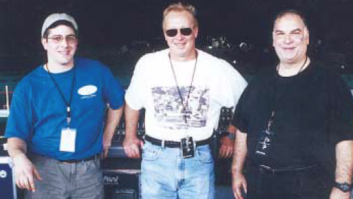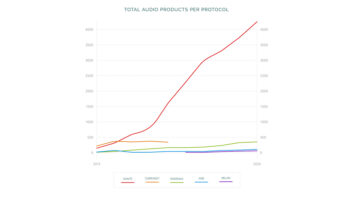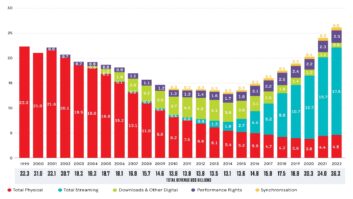PRODUCT HITS FROM FRANKFURT
March brought dueling trade shows: While the NSCA Convention went on in sunny Orlando (see report on page 44), those wishing to maintain studio tans checked out the hottest new software, hardware, instruments and audio gear at Frankfurt MusikMesse 2001, the granddaddy of music trade shows, from March 7 to 11. With more than 2,100 international exhibitors in nine exhibit halls, there was something for everyone. Here are some of our favorites…
One of the biggest introductions at the show had to be Mackie‘s (www.mackie.com) hardware controller for Emagic‘s Logic Audio. The first product of the strategic partnership between Emagic and Mackie, Logic Control has eight 100mm motorized, touch-sensitive P&G faders, Mackie’s rotary V-Pots, and transport and jog/shuttle wheel controls. The controller provides for hands-on adjustment of hundreds of MIDI and audio functions, with simultaneous control over multiple parameters of software instruments and plug-ins. Up to 128 channels can be addressed via bank-switching, and two Logic Control XT extender fader packs can be added for 24 simultaneous motorized fader controls. The Logic Control base unit lists for $799, and is expected to ship next quarter.
Meanwhile, Emagic (www.emagic.de) debuted Logic Audio 5. The redesigned automation is now tied to individual tracks, with 32-bit fader values, and automation data can be copied or moved with objects. Logic plug-ins keep on coming: Logic Platinum 5 now has more than 50! In addition, 24 Audio Instruments are supported in Platinum 5, and hardware-independent scrubbing and high-end dithering have been implemented.
iZ Technology released Version 3.1 software for RADAR, which makes it compatible with other DAWs, with a new Export to Broadcast Wave and .WAV2 function; exported projects can be loaded onto computers equipped with a DVD-RAM or standard DVD-ROM drive, and then dragged and dropped directly into workstation applications for mastering or mixing. The 3.1 release adds the ability to transfer files between multiple RADAR 24 machines via Ethernet, and iZ also announced Version 2.50 upgrade to RADAR II, free to all Otari RADAR users. Version 2.50 features enhanced graphics, accommodation of multiple SCSI backup devices and Macro import and export, and many improvements made during RADAR 24 development. Either upgrade is available at iZ’s Website, www.recordingtheworld.com.
Shipping this quarter, Steinberg‘s (www.steinberg.de) Nuendo 1.5 offers editing enhancements developed for both music and post-production. These include Open TL import/export for Tascam MMR-8 dubbers, Premiere EDL import, and support for additional audio file formats like MP3 and video options such as DirectShow. Full VST 2.0 support is also provided, and V.1.5 is fully compatible with Steinberg’s new HALion software sampler. The Nuendo Surround Edition is a set of six plug-in tools designed exclusively for Nuendo, offering multichannel compression, EQ, reverb and more. Finally, the new Nuendo 8 I/O 96k offers sampling frequencies up to 96 kHz, dithering and storage of all settings.
Celemony (www.celemony.com) says its Melodyne software will extract notes from mono audio tracks and let you then edit melody, pitch, duration, formant and transitions. Melodies can be recorded directly into Melodyne or imported. Once in the Melody Editor, notes can be grabbed and moved to any pitch or time position. Phrasing is preserved, but vibrato and transitions can be edited (getting that Cher sound, for example). Up to 20 tracks can be processed in real time. Melodies can be saved as MIDI files, or pitch and amplitude information can be exported. Melodyne supports ASIO2 and hosts VST1 plug-ins.
The Behringer (www.behringer.com) V-Amp marks its entry into the funky-looking-amp-modeler market. This guitar body-shaped box has 16 amp models emulating classic guitar amps, with settings like Brit Class A and Tweed Combo, with 15 cabinet simulations and stereo effects including delay, chorus, flange, tremolo, compression, rotary speaker emulation and more. Retailing at $269, the V-Amp comes with dual footswitch and gig bag. Now all it needs is a fretboard.
Pulsar XTC is CreamWare‘s (www.creamware.de) new VST-compatible DSP hardware/software system. The PCI card adds six 32-bit SHARC processors and four I/O options, each providing up to 28 I/Os and 24-bit/96kHz resolution. (The processing power is scalable with additional DSP cards.) Software includes more than 30 effects plug-ins from the SCOPE/SP system and an assortment of virtual instruments, including Vectron Player, based on vector synthesis. Pulsar XTC includes CreamWare’s new Volkzämpler, which allows sampling at up to 96 kHz with 32-bit resolution, an extensive graphical editor and compatibility with a variety of standard formats. List is $999.
Audient (www.audient.co.uk) showed the ASP 510 console surround controller. The remote unit offers comprehensive control of monitoring and record functions for surround formats, including 5.1, LCRS, Dolby Surround, DVD-Video, DVD-Audio, SACD and DTS. The ASP 510 integrates with any console and supports three 6-channel and three 2-channel sources, a 6-channel speaker output, and 2-channel and 6-channel recorder outs.
Waves (www.waves.com) demoed its new Renaissance Bass plug-in for TDM and Mac native (Windows on the way) platforms. The Renaissance Bass technology is the second-generation MaxxBass algorithm for pychoacoustic bass enhancement, with a simplified user interface.
Berkley Integrated Audio Software (www.bias-inc.com) introduced Version 3.0 of its Deck multitrack audio workstation. This upgrade enhances Deck’s real-time effects capabilities and updates the user interface. Following the recent release of Deck 2.7, which added ASIO support, Deck 3.0 offers support for VST and a completely redesigned graphical interface. Deck 3.0 will be available this quarter, for a suggested retail price of $399.
VIRTUAL SYNTHS KEEP COMING!
Of course, no visit to MusikMesse would be complete without checking out some cool software synths: Native Instruments (www.native-instruments.de) showed the FM7, which re-creates good old FM synthesis and adds distortion, filter operators, modulation, effects and more. The FM7 can read and reproduce sound libraries from the original DX7, DX7-II, DX11, TX81Z, DX21, DX27, DX100 and TX802. It runs either as a stand-alone or as a plug-in, supporting VST 2.0, Dxi, Direct Connect, MAS and ASIO. Absynth, another new software synth from NI, offers graphical breakpoint envelopes, multiple synthesis techniques, MIDI and modulation. Our coolest-swag-of-the-show award goes to Native Instruments for handing out free absinthe (the green liquid kind) at the booth.
Emagic announced lots of new software products, but our favorite was the ES2 synth, with up to 16-note polyphony, three oscillators per voice (oscillators 2 and 3 can sync to oscillator 1), and analog and digital source waveforms, including FM, Ring Mod, Noise and more. A time-based effects processor offers chorus, flanging and phasing. Emagic also introduced the EVO20 multiband vocoder/formant filter for Logic Audio and EVP88, a vintage electric piano synth. Steinberg announced Waldorf Attack, a VST percussion synth (featured on page 110).
The VirSyn software synth combines analog and digital synthesis with physical models, with a user interface that navigates through an 8-dimensional sound space. Up to 12 modular synthesizers can be used simultaneously; effects are included. Check out www.virsyn.com for more information.
Look for more cool stuff from MusikMesse in our regular product columns in future issues. Next month: hits from NAB!





